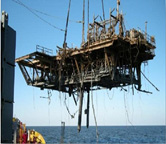Decommissioning
Decommissioning Liability Assessment WorkshopThursday, August 25, 2016 – New Orleans, LAAt this workshop, BSEE staff will provide insight into the methodology and updates on the implementation of BSEE's decommissioning liability assessments. Date: August 25, 2016 Doors will open at 12:45 PM. Registration for this forum is free, though space is limited. Registration is limited to two representatives for each organization. Please register for the afternoon workshop by sending your name, company, and contact information to BSEEworkshop@bsee.gov A wait list will be in place if registration reaches the capacity at the location. Registration will close on Monday, Aug. 22, 2016 at 5 PM CDT. |
When a company signs a lease for offshore oil or gas exploration or production, Right-of-Way or Right-of-Use-and-Easement, that initial agreement includes the process of “decommissioning” the well, that is, safely plugging the hole in the earth's crust, and disposing of the equipment used to support the production. This process is critical for environmental protection after a well is drilled, utilized for production, then plugged and sealed when the well is exhausted, in the Outer Continental Shelf (OCS).
Decommissioning regulation authority for BSEE began with 43 U.S. Code 1334 and 30 CFR 250, Subpart Q, Decommissioning Activities. These provide deeper detail regarding regulations for sealing the well, to protect the environment and people using the waters around it.
Approximately 2,996 active production platforms exist on the OCS with more than 40% of these facilities more than 25 years old. (Platforms are facilities which facilitate the extraction and processing of oil and natural gas, different from drilling rigs which “drill” a well to discover hydrocarbons and bring them to the surface for processing). Over the past decade, the offshore energy industry has averaged 130 platform removals per year.
 Platforms generally consist of two parts for decommissioning purposes: the topside (the structure visible above the waterline) and the substructure (the parts between the surface and the seabed, or mudline). In most cases the topsides that contain the operational components are taken to shore for recycling or re-use. The substructure is generally severed 15 feet below the mudline, then removed and brought to shore to sell as scrap for recycling or refurbished for installation at another location.
Platforms generally consist of two parts for decommissioning purposes: the topside (the structure visible above the waterline) and the substructure (the parts between the surface and the seabed, or mudline). In most cases the topsides that contain the operational components are taken to shore for recycling or re-use. The substructure is generally severed 15 feet below the mudline, then removed and brought to shore to sell as scrap for recycling or refurbished for installation at another location.
The Regional Supervisor may grant a departure from the requirement to remove a structure by approving partial structure removal or toppling in place for conversion to an artificial reef if the operator meets the requirements of the National Artificial Reef Plan as permitted by several U.S. Federal agencies. State government agencies are responsible for managing marine fisheries resources programs.
As a result of successful initiatives to provide new habitat for marine life, ships and platforms which have reached the end of their useful life are sunk in pre-approved places to create artificial reefs. Today the National Oceanic and Atmospheric Administration (NOAA) has overall responsibility for the program, working with many other state and federal agencies, including BSEE.
